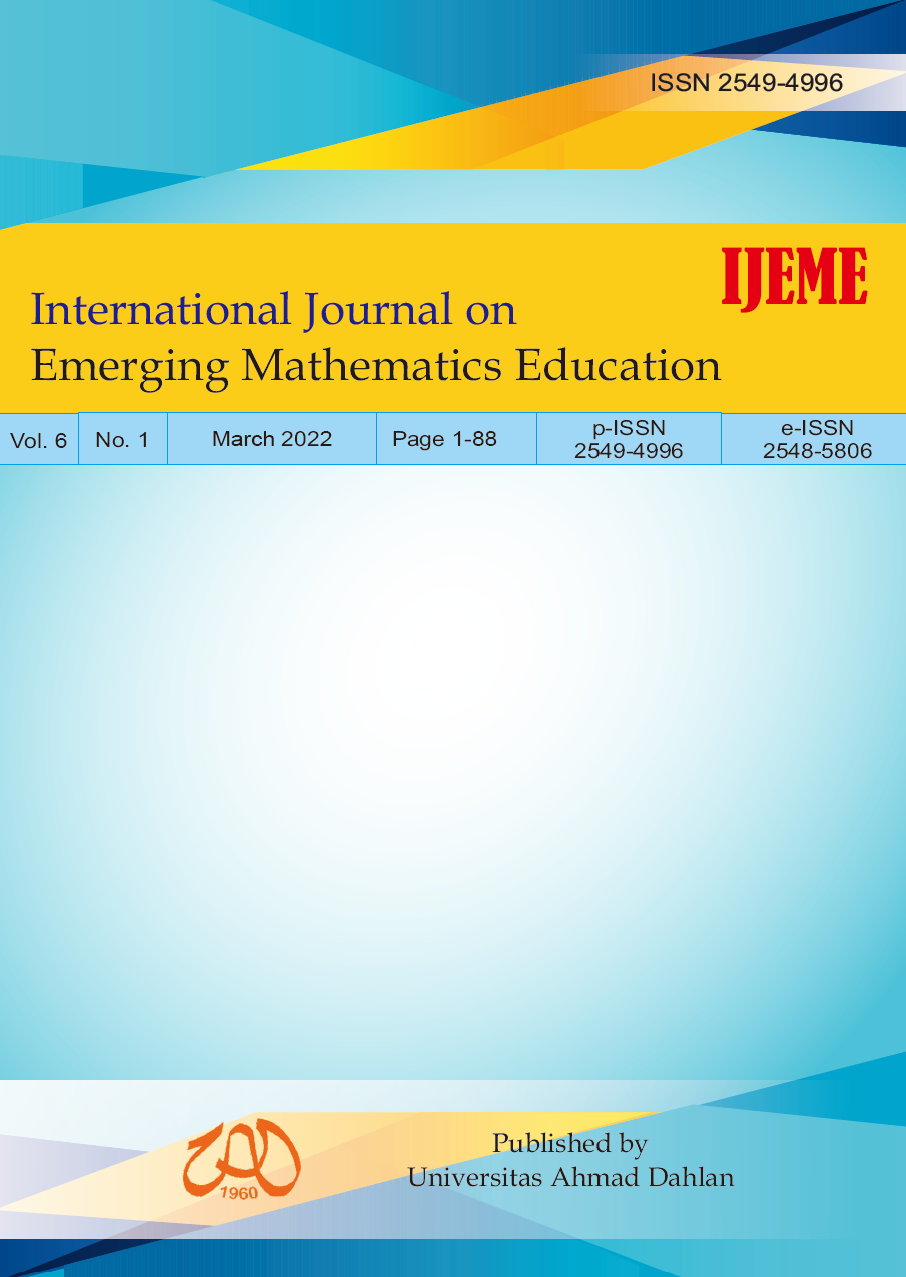Influence of Teacher-Student Relationships on Mathematics Problem-Solving
DOI:
https://doi.org/10.12928/ijeme.v6i1.20186Keywords:
Affective skills, Colaizzi method, Exploratory factor analysis, Mathematics problem-solving, Phenomenology, Social skillsAbstract
Literatures revealed that the cognitive and affective components are the factors affecting problem solving. In this article we identified factors considered by the students in learning mathematical problem solving. Using a descriptive phenomenological research we explored the lived experiences of forty-five (45) student’s in solving a mathematics problem. Following the Colaizzi method for data analysis, four themes emerged: emotions and self- efficacy as affective factors, and group learning activity and teacher- student relationship as social factors. Sixty items from these four themes were further explored in using an Exploratory Factor Analysis (EFA) for a new set of 200 students. These four-factor structures of the student’s experiences in mathematics problem solving explained 66% of the variance in the pattern of relationships among the items. All four-factor structures had high reliabilities (all at or above Cronbach’s α > .904). The study exemplified that teacher- student interaction relationship during learning activities, which is a social factor, provides the highest correlated factor that influences the mathematical performance of the students.References
Agustyaningrum, N., Sari, R. N., Abadi, A. M., & Mahmudi, A. (2021). Dominant Factors that Cause Students Difficulties in Learning Abstract Algebra: A Case Study at a University in Indonesia. International Journal of Instruction, 14(1).
AydoÄŸdu, M. Z., & KeÅŸan, C. (2014). A research on geometry problem solving strategies used by elementary mathematics teacher candidates. Engineering Sciences & Technologies/Nauki Inzynierskie i Technologie, 4(1).
Azimova, M. (2020). Self-confidence in Oral Performance. Bulletin of Science and Practice, 6(4), 444-452.
Bandura, A., & Walters, R. H. (1977). Social learning theory (Vol. 1). Englewood Cliffs, NJ: Prentice-hall.
Brucal, J. W. A., Perez, J. C., Enoslay, I., & Liwanag, D. C. (2019). Answer-Giving Strategy: An Effective Way in Dealing with Mathematical Problem. International Journal of Recent Innovations in Academic Research, 3(1), 193-198.
Christensen, M., Welch, A., & Barr, J. (2017). Husserlian Descriptive Phenomenology: A review of intentionality, reduction and the natural attitude. Journal of Nursing Education and Practice, 7(8), 113-118.
Colaizzi, P. F. (1978). Psychological research as the phenomenologist views it.
Fauziah, R. (2020, October). Mathematical problem-solving ability using flipping classroom with relating, experiencing, applying, cooperating, and transferring learning strategy. In Journal of Physics: Conference Series (Vol. 1663, No. 1, p. 012055). IOP Publishing.
Hair Junior, J. F., Black, W. C., Babin, B. J., Anderson, R. E., & Tatham, R. L. (1998). Multivariate data analysis. New Jersey.
Hannula, M. S. (2015). Emotions in problem solving. In Selected regular lectures from the 12th international congress on mathematical education (pp. 269-288). Springer, Cham.
Hendricks, C. C. (2017). Improving schools through action research: A reflective practice approach. Pearson. One Lake Street, Upper Saddle River, New Jersey 07458.
Hinkin, T. R., Tracey, J. B., & Enz, C. A. (1997). Scale construction: Developing reliable and valid measurement instruments. Journal of Hospitality & Tourism Research, 21(1), 100-120.
Kaiser, H. F. (1960). The application of electronic computers to factor analysis. Educational and psychological measurement, 20(1), 141-151.
Matsunaga, M. (2010). How to Factor-Analyze Your Data Right: Do's, Don'ts, and How-To's. International journal of psychological research, 3(1), 97-110.
Osborne, J. W., Costello, A. B., & Kellow, J. T. (2014). Best practices in exploratory factor analysis (pp. 86-99). Louisville, KY: CreateSpace Independent Publishing Platform. [18] Bandura, A., & Walters, R. H. (1977). Social learning theory (Vol. 1). Englewood Cliffs, NJ: Prentice-hall.
Sanders, C. (2003). Application of Colaizzis method: Interpretation of an auditable decision trail by a novice researcher. Contemporary nurse, 14(3), 292-302.
Singer, F. M., Ellerton, N. F., & Cai, J. (Eds.). (2015). Mathematical problem posing: From research to effective practice. Springer.
Taylor, A. Z., & Graham, S. (2007). An examination of the relationship between achievement values and perceptions of barriers among low-SES African American and Latino students. Journal of Educational Psychology, 99(1), 52.
Wassler, P., & Kuteynikova, M. (2020). Living travel vulnerability: A phenomenological study. Tourism Management, 76, 103967.
Wurdinger, S., & Qureshi, M. (2015). Enhancing college students life skills through project based learning. Innovative Higher Education, 40(3), 279-286.
Downloads
Published
How to Cite
Issue
Section
License
License and Copyright Agreement
In submitting the manuscript to the journal, the authors certify that:
- They are authorized by their co-authors to enter into these arrangements.
- The work described has not been formally published before, except in the form of an abstract or as part of a published lecture, review, thesis, or overlay journal. Please also carefully read the International Journal on Emerging Mathematics Education (IJEME) Author Guidelines at http://journal.uad.ac.id/index.php/IJEME/about/submissions#authorGuidelines
- That it is not under consideration for publication elsewhere,
- That its publication has been approved by all the author(s) and by the responsible authorities, tacitly or explicitly, of the institutes where the work has been carried out.
- They secure the right to reproduce any material that has already been published or copyrighted elsewhere.
- They agree to the following license and copyright agreement.
Copyright
Authors who publish with the International Journal on Emerging Mathematics Education (IJEME) agree to the following terms:
- Authors retain copyright and grant the journal the right of first publication with the work simultaneously licensed under a Creative Commons Attribution License (CC BY-SA 4.0) that allows others to share the work with an acknowledgment of the work's authorship and initial publication in this journal.
- Authors are able to enter into separate, additional contractual arrangements for the non-exclusive distribution of the journal's published version of the work (e.g., post it to an institutional repository or publish it in a book), with an acknowledgment of its initial publication in this journal.
- Authors are permitted and encouraged to post their work online (e.g., in institutional repositories or on their website) prior to and during the submission process, as it can lead to productive exchanges, as well as earlier and greater citation of published work.
![]()
Ciptaan disebarluaskan di bawah Lisensi Creative Commons Atribusi-BerbagiSerupa 4.0 Internasional.





